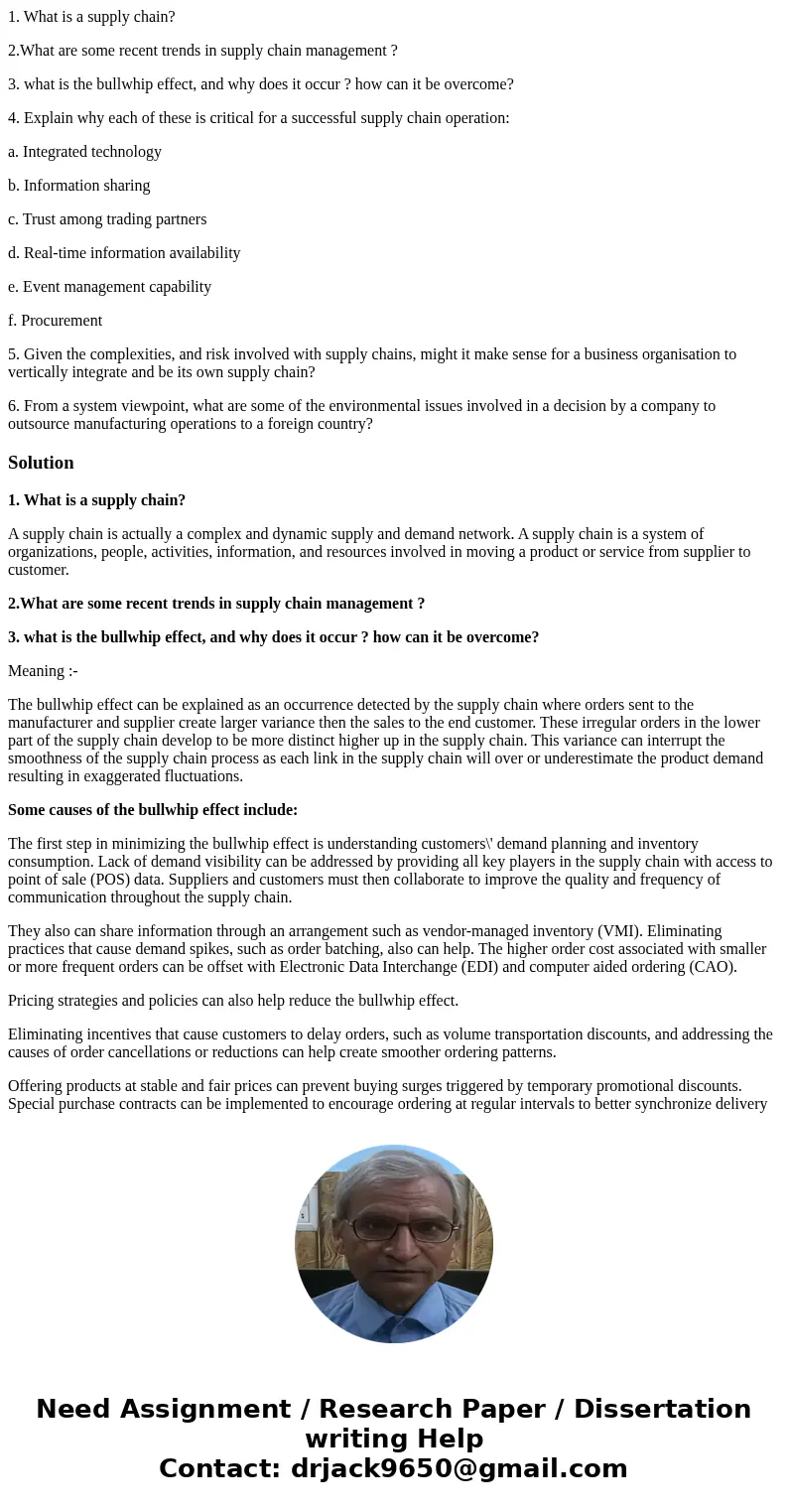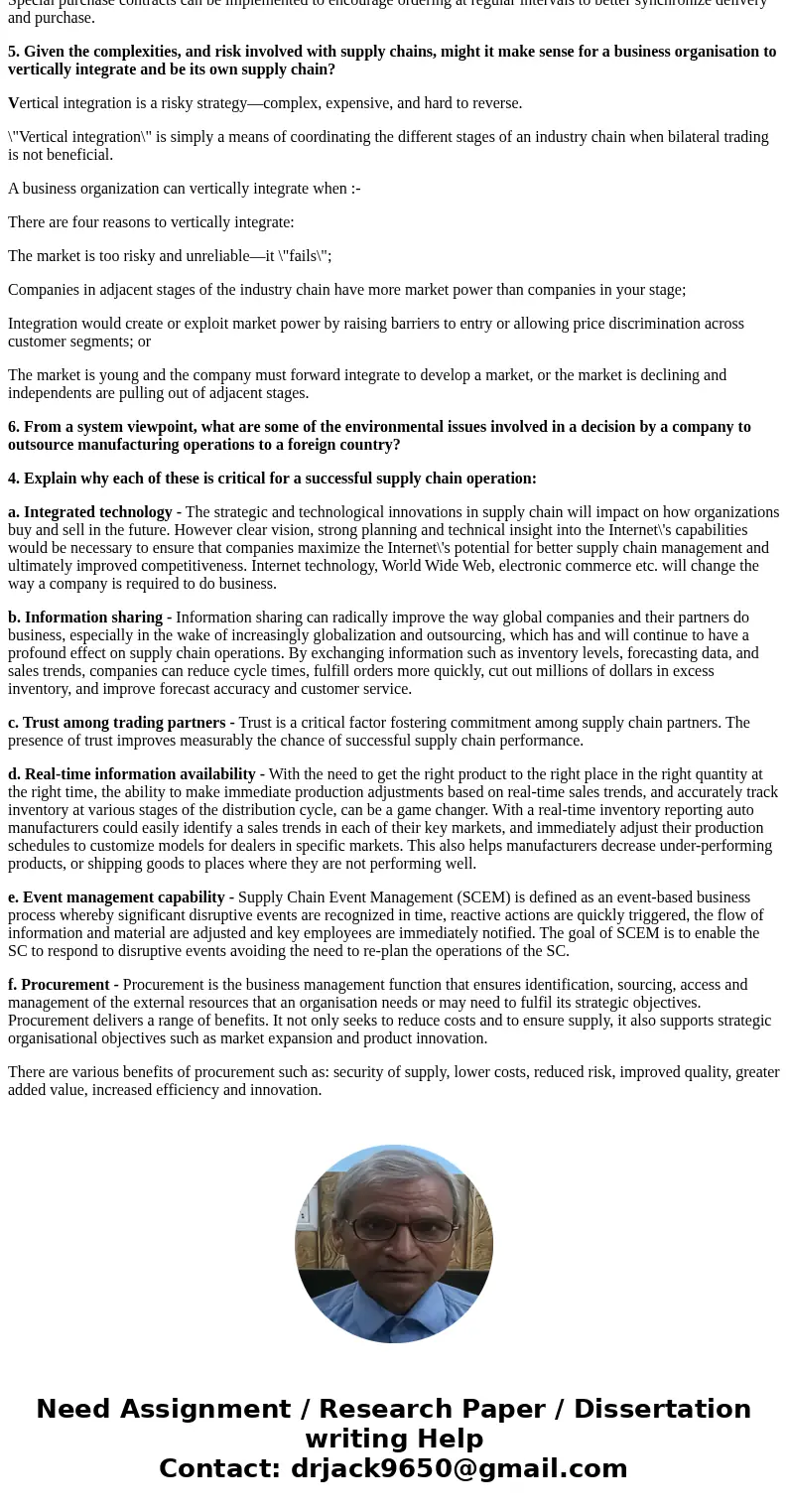1 What is a supply chain 2What are some recent trends in sup
1. What is a supply chain?
2.What are some recent trends in supply chain management ?
3. what is the bullwhip effect, and why does it occur ? how can it be overcome?
4. Explain why each of these is critical for a successful supply chain operation:
a. Integrated technology
b. Information sharing
c. Trust among trading partners
d. Real-time information availability
e. Event management capability
f. Procurement
5. Given the complexities, and risk involved with supply chains, might it make sense for a business organisation to vertically integrate and be its own supply chain?
6. From a system viewpoint, what are some of the environmental issues involved in a decision by a company to outsource manufacturing operations to a foreign country?
Solution
1. What is a supply chain?
A supply chain is actually a complex and dynamic supply and demand network. A supply chain is a system of organizations, people, activities, information, and resources involved in moving a product or service from supplier to customer.
2.What are some recent trends in supply chain management ?
3. what is the bullwhip effect, and why does it occur ? how can it be overcome?
Meaning :-
The bullwhip effect can be explained as an occurrence detected by the supply chain where orders sent to the manufacturer and supplier create larger variance then the sales to the end customer. These irregular orders in the lower part of the supply chain develop to be more distinct higher up in the supply chain. This variance can interrupt the smoothness of the supply chain process as each link in the supply chain will over or underestimate the product demand resulting in exaggerated fluctuations.
Some causes of the bullwhip effect include:
The first step in minimizing the bullwhip effect is understanding customers\' demand planning and inventory consumption. Lack of demand visibility can be addressed by providing all key players in the supply chain with access to point of sale (POS) data. Suppliers and customers must then collaborate to improve the quality and frequency of communication throughout the supply chain.
They also can share information through an arrangement such as vendor-managed inventory (VMI). Eliminating practices that cause demand spikes, such as order batching, also can help. The higher order cost associated with smaller or more frequent orders can be offset with Electronic Data Interchange (EDI) and computer aided ordering (CAO).
Pricing strategies and policies can also help reduce the bullwhip effect.
Eliminating incentives that cause customers to delay orders, such as volume transportation discounts, and addressing the causes of order cancellations or reductions can help create smoother ordering patterns.
Offering products at stable and fair prices can prevent buying surges triggered by temporary promotional discounts. Special purchase contracts can be implemented to encourage ordering at regular intervals to better synchronize delivery and purchase.
5. Given the complexities, and risk involved with supply chains, might it make sense for a business organisation to vertically integrate and be its own supply chain?
Vertical integration is a risky strategy—complex, expensive, and hard to reverse.
\"Vertical integration\" is simply a means of coordinating the different stages of an industry chain when bilateral trading is not beneficial.
A business organization can vertically integrate when :-
There are four reasons to vertically integrate:
The market is too risky and unreliable—it \"fails\";
Companies in adjacent stages of the industry chain have more market power than companies in your stage;
Integration would create or exploit market power by raising barriers to entry or allowing price discrimination across customer segments; or
The market is young and the company must forward integrate to develop a market, or the market is declining and independents are pulling out of adjacent stages.
6. From a system viewpoint, what are some of the environmental issues involved in a decision by a company to outsource manufacturing operations to a foreign country?
4. Explain why each of these is critical for a successful supply chain operation:
a. Integrated technology - The strategic and technological innovations in supply chain will impact on how organizations buy and sell in the future. However clear vision, strong planning and technical insight into the Internet\'s capabilities would be necessary to ensure that companies maximize the Internet\'s potential for better supply chain management and ultimately improved competitiveness. Internet technology, World Wide Web, electronic commerce etc. will change the way a company is required to do business.
b. Information sharing - Information sharing can radically improve the way global companies and their partners do business, especially in the wake of increasingly globalization and outsourcing, which has and will continue to have a profound effect on supply chain operations. By exchanging information such as inventory levels, forecasting data, and sales trends, companies can reduce cycle times, fulfill orders more quickly, cut out millions of dollars in excess inventory, and improve forecast accuracy and customer service.
c. Trust among trading partners - Trust is a critical factor fostering commitment among supply chain partners. The presence of trust improves measurably the chance of successful supply chain performance.
d. Real-time information availability - With the need to get the right product to the right place in the right quantity at the right time, the ability to make immediate production adjustments based on real-time sales trends, and accurately track inventory at various stages of the distribution cycle, can be a game changer. With a real-time inventory reporting auto manufacturers could easily identify a sales trends in each of their key markets, and immediately adjust their production schedules to customize models for dealers in specific markets. This also helps manufacturers decrease under-performing products, or shipping goods to places where they are not performing well.
e. Event management capability - Supply Chain Event Management (SCEM) is defined as an event-based business process whereby significant disruptive events are recognized in time, reactive actions are quickly triggered, the flow of information and material are adjusted and key employees are immediately notified. The goal of SCEM is to enable the SC to respond to disruptive events avoiding the need to re-plan the operations of the SC.
f. Procurement - Procurement is the business management function that ensures identification, sourcing, access and management of the external resources that an organisation needs or may need to fulfil its strategic objectives. Procurement delivers a range of benefits. It not only seeks to reduce costs and to ensure supply, it also supports strategic organisational objectives such as market expansion and product innovation.
There are various benefits of procurement such as: security of supply, lower costs, reduced risk, improved quality, greater added value, increased efficiency and innovation.


 Homework Sourse
Homework Sourse